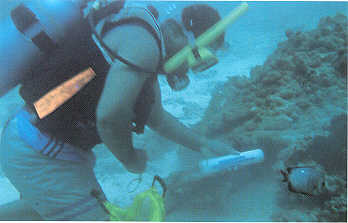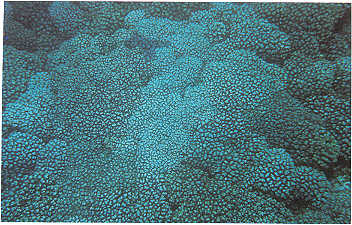
Oman's Unique Coral Environment
In Chapter 2, we pointed out that both the general abundance and numbers of coral types found in Oman are substantially less than elsewhere in the Indo-Pacific region. This may be partly explained by the remoteness of Oman from the regional center of coral abundance and diversity, by the geological youth of the coastline and by the lack of suitable surfaces for coral settlement and growth. However, the Red Sea is even more isolated than Oman from the rest of the Indo-Pacific region and is also one of the world's most recent ocean regions, still in the process of formation. Much of the Red Sea's nearshore environment is sedimentary, yet the Red Sea supports some of the world's most flourishing and diverse coral reef communities, not far from the coast of Oman.
A principal reason for this difference
in corat reef development between the two areas is that corals and
reefs along most of the Oman coast are exposed to one of the most unique
temperature and nutrient environments of any coral growing area in the
world. This is most pronounced in the Dhofar region where summer
upwelling generated by the southwest monsoon's winds from June through
August reduces surface water temperatures to 16-19°C (61-66°F).
This is approximately 10°C (18°F) lower than the temperatures that
are considered optimal for coral growth and development. At
the same time, the concentrations of dissolved phosphorus and nitrogen
nutrients increase by as much as 100 times their normal values, causing
dramatic elevations in plankton populations, decreases in water clarity
and possibly, bloomsof toxic algal forms. These changes in temperature,
nutrients and turbidity also produce rapid growth of brown macroalgae and
kelps that may completely overgrow reef corals during the summer.
Because the shallow water, benthic communities of temperate areas are usually
dominated by macroalgae, and tropical areas are usually dominated by reef
corals, this shift in community dominants during the summer has been termed
a 'pseudo-high latitude effect'. This occurs annually, despite the fact
that coral growing areas in southern Oman are at about 17°N latitude,
well within the normal tropical zone.

The
low temperatures and elevated nutrients from upwelling are probably the
principal limitation to the developmentof reef structures in the Dhofar
area and act as a barrier to spreading of more coral species from the Red
Sea. This annual upwelling effect is continuous and pronounced as far north
as Ras al Hadd. Upwelling effects have been measured on coral
reefs in the Capital Area, where summer temperatures can decrease and
vary radically over short time periods, as gyres of cold, deep water sweep
into shallow areas. At some locations
in the Muscat area not only do corals have to withstand exposure to low
temperatures, they may also have to resist again being exposed within a
few hours to high temperatures that are near their upper lethal limits.
The
figure below (Figure 4) shows temperatures neasured every three hours by
a continuously recording instrument at 10 m depth on the south side of
Al Fahl Island in the summer months of 1994. During July and August, when
the influence of upwelling was at its maximum, temperatures at this site
and depth routinely ranged from around 32°C (90°F) to below 24°C
(75°F). On five days from August 8 through August 11 temperature fluctuated
daily by 7 to 8°C (12.6 to 14.4°F), rising each day to 31°C
or more.

Figure 4. Water temperatures recorded at 10 m depth,
Al Fahl Island, 1994
Very similar results were measured at this site in late August 1992, indicating that this is a normal annual occurrence at locations in the Capital Area, at intermediate depths which can be affected by both warm surface and cold deep water during the summer. These temperature fluctuations, which exceed any previously reported for short term periods anywhere in the world where reef corals grow, were measured on a flourishing reef with abundant coral species which have apparently adapted well to these erratic temperature conditions.
Along with these rapid summer temperature
fluctuations Oman's reef corals can experience maximum temperatures
which are among the highest that have been measured in the world and which
would normally be considered lethal to corals. The earliest and most visible
symptom of this high temperature stress is the disruption of the symbiotic
association between a coral's tissue and its zooxanthellae algae (Chapter
1). The zooxanthellae, which are normally contained within the animal's
cells and give the coral its characteristic brown or green color, are ejected
from the coral when temperatures exceed a maximum tolerance,
leaving the coral in a pale or 'bleached' condition in which the white
coral skeleton is clearly visible through the transparent tissue. If lower
temperatures return, the coral can re-acquire its complement of zooxanthellae
and continue with normal growth. However, extended periods of elevated
temperature will result in mortality of bleached corals and a decline in
the structural integrity of the coral reef. Instances
of coral bleaching has been much more widely reported throughout the tropics
in the last decade than in previous years, and coral bleaching has been
proposed as a possible symptom of global warming due to the "greenhouse
effect" resulting from increased concentrations of carbon dioxide and other
gases in the earth's atmosphere.

Oman's normal summer maximum sea surface temperatures of around 32°C (90°F) are well above the temperatures that have previously been found to induce coral bleaching. inareas such as Panama, Tahiti and the Great Barrier Reef, where annual maximum temperatures are around 29°C (84°F), extensive coral bleaching has resulted when unusual environmental conditions have raised temperatures to above 30°C (86°F) for extended periods. Coral bleaching does not normally occur at 32°C on Oman's reefs or further north in the Arabian Gulf where summer temperatures may reach even higher, suggesting that corals in this region have been able to adapt to higher temperatures. However, coral bleaching has been previously reported by Dr Rodney Salm in the waters of Oman during periods of exceptionally high temperatures. Coral bleaching took place in the Muscat area in 1990 when shallow water temperatures were reported to reach 39°C (102°F). However there was little sign of coral mortality a few months later, suggesting that even these high temperatures were sublethal for the timeof their exposure. By contrast, mortality of up to 95% of the corals in depths of less than 3 m occurred in the Musandam area following coral bleaching during the same year. Water temperatures at Musandam ranged only from 32 to 35°C (90 to 95°F) during this period, but were considered to have been more continuous than at Muscat, since the Musandam is beyond the influence of cold water upwelling. Therefore, the much higher temperatures that occurred in the Capital Area compared to the Musandam were probably too brief to be lethal to corals.
These
examples indicate the unusual and stressful temperature environment that
corals and other coral reef organisms must withstand to live along the
coast of Oman. These conditions are virtually unique in the world,
and we must surmise that only the species which are most tolerant to temperature
stress can survive here. Other physical factors, such as the instability
of the rock cliffs in the Musandam, periodic high levels of nutrient
and turbidity, and general lack of suitable hard substratum must
all contribute to general lack of reef development and limited number of
species that occur along Oman's coast. However, temperature extremes, both
long and short term, are almost certainly the primary factors
limiting reef coral growth and survival in this unusual environment.